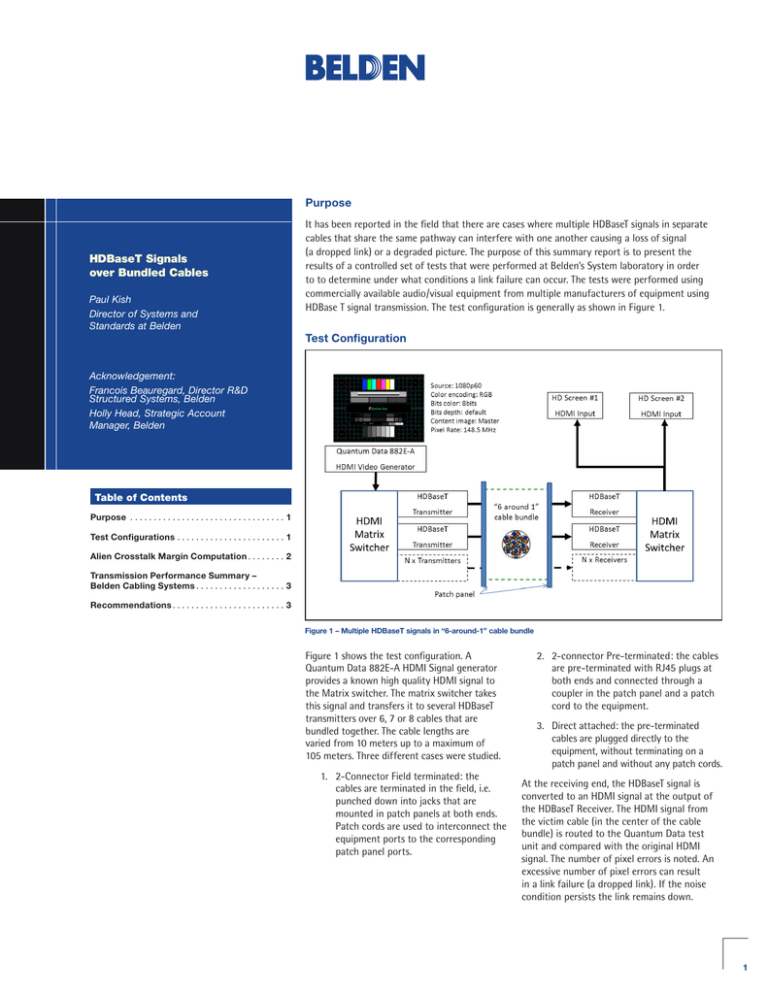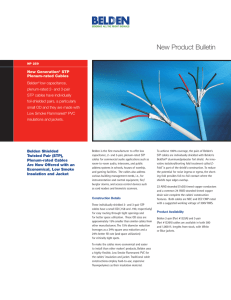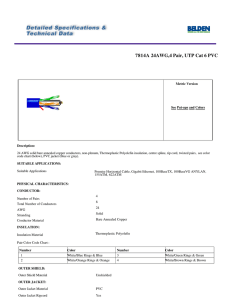HDBaseT Signals over Bundled Cables Purpose Test Configuration
advertisement

Purpose HDBaseT Signals over Bundled Cables Paul Kish Director of Systems and Standards at Belden It has been reported in the field that there are cases where multiple HDBaseT signals in separate cables that share the same pathway can interfere with one another causing a loss of signal (a dropped link) or a degraded picture. The purpose of this summary report is to present the results of a controlled set of tests that were performed at Belden’s System laboratory in order to to determine under what conditions a link failure can occur. The tests were performed using commercially available audio/visual equipment from multiple manufacturers of equipment using HDBase T signal transmission. The test configuration is generally as shown in Figure 1. Test Configuration Acknowledgement: Francois Beauregard, Director R&D Structured Systems, Belden Holly Head, Strategic Account Manager, Belden Table of Contents Purpose . . . . . . . . . . . . . . . . . . . . . . . . . . . . . . . . . . 1 Test Configurations . . . . . . . . . . . . . . . . . . . . . . . . 1 Alien Crosstalk Margin Computation . . . . . . . . 2 Transmission Performance Summary – Belden Cabling Systems . . . . . . . . . . . . . . . . . . . 3 Recommendations . . . . . . . . . . . . . . . . . . . . . . . . 3 Figure 1 – Multiple HDBaseT signals in “6-around-1” cable bundle Figure 1 shows the test configuration. A Quantum Data 882E-A HDMI Signal generator provides a known high quality HDMI signal to the Matrix switcher. The matrix switcher takes this signal and transfers it to several HDBaseT transmitters over 6, 7 or 8 cables that are bundled together. The cable lengths are varied from 10 meters up to a maximum of 105 meters. Three different cases were studied. 1.2-Connector Field terminated: the cables are terminated in the field, i.e. punched down into jacks that are mounted in patch panels at both ends. Patch cords are used to interconnect the equipment ports to the corresponding patch panel ports. 2.2-connector Pre-terminated: the cables are pre-terminated with RJ45 plugs at both ends and connected through a coupler in the patch panel and a patch cord to the equipment. 3.Direct attached: the pre-terminated cables are plugged directly to the equipment, without terminating on a patch panel and without any patch cords. At the receiving end, the HDBaseT signal is converted to an HDMI signal at the output of the HDBaseT Receiver. The HDMI signal from the victim cable (in the center of the cable bundle) is routed to the Quantum Data test unit and compared with the original HDMI signal. The number of pixel errors is noted. An excessive number of pixel errors can result in a link failure (a dropped link). If the noise condition persists the link remains down. 1 Test Results Summary – Multiple HDBaseT Channels Operating in a Bundled Cable Environment A summary of the test results is shown in Figure 2 for Unshielded Twisted Pair (UTP) cables and Shielded (F/UTP) cables, where F/UTP designates a metal foil shield over a UTP core. The cable types that were tested in a bundled configuration include: • Belden 1200 series (Category 5e) UTP and F/UTP cables, • Belden 3600 series (Category 6+) UTP cables and • Belden 10GX series (Category 6A) UTP cables. The length of cables under test was varied from 10 meters up to a maximum of 105 meters. Shorter cable lengths provide a stronger signal at the input to the HDBaseT receiver and can tolerate more alien crosstalk noise between cables in a bundle. The results of these multidisturber system tests show that Category 5e UTP cables can only support distances up to 10 meters (~ = 30 ft) without link failures due to interference from neighbouring channels that are carrying HDBASET signals. Category 6 UTP cables can support distances between 30 to 40 meters (~ = 100 to 130 ft) without link failures when tested under the same conditions. Belden 10GX UTP (Category 6A) cables can support distances up to 105 meters (~ = 340 ft) without any link failures (see Note 1). These cables are specifically designed to provide about 15 dB or 32 times less “alien crosstalk” interference compared to Category 6 cables when bundled together. The test results also show that shielded F/UTP cables can support distances up to 105 meters (~ = 340 ft) without link failures due to alien crosstalk between channels (see Note 2). Figure 2 – Pass/Fail test results as a function of channel configuration, cable type and cable length Alien Crosstalk Margin Computation The IEEE 802.3 10GBASE-T Standard includes a requirement for the Alien Crosstalk Margin Computation (ACMC) from the combined effects of alien Near End Crosstalk (ANEXT) and alien Far End Crosstalk (AFEXT) between adjacent link segments. Currently, the HDBaseT specification (Version 1.1.0) does not include any alien crosstalk requirements. The procedure for testing alien crosstalk is illustrated in the left hand side of Figure 3 using the Fluke DTX 1800 field test instruments and the DTX-10GKIT. Also illustrated on the right hand side of Figure 3 are examples of the ACMC results that were measured for the test setup illustrated in Figure 1. What is interesting about these results is that the Pass/ Fail link status correlates very well with the measured ACMC. There is a zone of uncertainty when the ACMC is within +/- 3 dB where the link status may sometimes Pass and sometimes Fail. When the ACMC is less than -3 dB all links Fail. When the ACMC is greater than + 3dB, all links Pass. ACMC can be used as a criterion to determine whether multiple HDBaseT applications can be supported over installed cables sharing the same pathway. Testing for alien crosstalk in the field can be quite time consuming. For new installations, it is recommended to install cabling systems that are not susceptible to alien crosstalk interference. Note 1) Belden 10GX UTP cables are designed to provide very good alien crosstalk isolation in a worst case environment with the cables tightly bundled. The pairs are very well balanced and the 10GX system is not affected by the problem of ground loops (ground potential differences) that can occur with shielded systems. Note 2) S hielded cables rely on the integrity of the shield and a low impedance path to ground to provide alien crosstalk isolation. If the shield is broken and not connected to ground at both ends, the alien crosstalk noise can be worse than UTP cables. 2 Figure 3 – Alien Crosstalk test setup and correlation of ACMC with the Pass/Fail link status Transmission Performance Summary – Belden Cabling Systems The test results presented in Figure 2 show the predominant effect of alien crosstalk from multiple HDBASET signals that are transmitted over cables that share the same pathway, i.e. bundled together. From these results it is concluded that either Category 6A UTP cables or shielded cables are needed to minimize the effect of alien crosstalk interference. In selecting a cabling system for a particular application, it is important to look at all the transmission parameters and not only the alien crosstalk performance. The relative transmission performance for Belden’s Cabling Systems are shown in Table 1 compared to the TIA 568-C.2 cabling Standard. As a relative benchmark, Belden’s 2400 series (Category 6) solution provides a bandwidth that is 150 MHz higher than Category 5e, an Insertion Loss (signal strength) that is 17% better than Category 5e, a Return Loss (signal reflections) that is 6 dB better, PSNEXT (power sum near end crosstalk) is 14 dB better and PSACRF (power sum attenuation to crosstalk ratio at the far end) that is 11.4 dB better than Category 5e. Because of the enabling technologies that are built into Belden’s 10GX system (cable, connector and cord), the transmission performance is the best among the available choices, see http://www.belden. com/docs/upload/10GX_WP.pdf. It provides an available bandwidth that extends up to 625 MHz and a guaranteed performance for all parameters, see http://www.belden.com/ docs/upload/10GX-CertificateSummary.pdf. Table 1 – Performance of Belden cabling systems relative to TIA-568-C.2 Standards Recommendations Based on the results of the multi-disturber HDBaseT system testing and the transmission performance summary shown in Table 1, Belden’s 10GX (Category 6A UTP) cabling system is recommended as a first choice for A/V applications that use HDBaseT technology. As an alternate choice, Belden 2400F series (Category 6+ F/UTP) shielded systems can be used. Belden 2400F series cables are preferred over Belden’s 1200F series (Category 5e) cables because of the lower attenuation (stronger signal) and improved transmission performance at high frequencies. When installing shielded systems it is important to maintain shielding integrity at all connection points and to ensure a low resistance path to ground as specified in the TIA-607-B Bonding and Grounding Standard. Belden Technical Support 1.800.BELDEN.1 (1.800.235.3361) © Copyright 2012, Belden Inc. www.belden.com HDBTWP 2012 3

